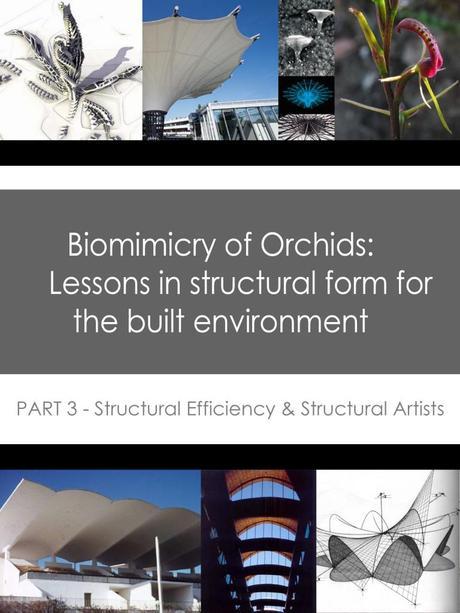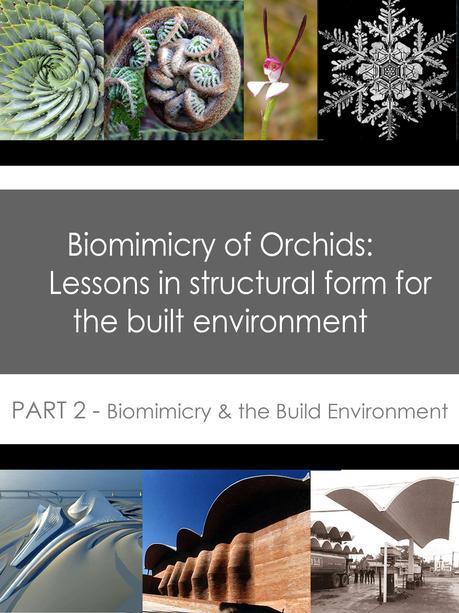
Biomimicry of Orchids: Lessons in structural form for the built environment –
PART 2 – Biomimicry & the Built Environment
2. BIOMIMICRY AND THE BUILT ENVIRONMENT
2.1. The role of built environment and structural efficiency on sustainability
It is estimates that the built environment accounts for roughly 40% of energy consumption and 50% of greenhouse gas emissions (Woodruff, 2008). This, in combined with the construction sectors influence on material extraction and consumption, is likely to substantiate the built environment as the single greatest influence on sustainability. Webster (2004, pp. 181) highlights the significant role of structural systems within the built environment, which he states ‘account for more than one-third of the material use and waste generation and more than 10% of the energy use and greenhouse gas production over a building lifespan of 50 years’ (2004, pp. 181). Whilst Webster acknowledges structural systems currently play a lesser role to the energy use over the life of the building, with the advent of renewable technologies, he suggests, the overall significance of structural systems will inevitably grow by comparison. Furthermore, the developments of renewable energy and technologies are largely beyond the influence of architects and structural engineers and considering the holistic nature of sustainability, advancements will be needed in all aspects of the built environment.
At present structural systems tend to be largely predetermined, following straight lines and flat planes, which the construction industry has long focused its efforts. Eladio Dieste (1917-2000) was critical of this often indiscriminate selection as he states it ‘does not make use of materials in any rational way’ (Anderson 2004: pp. 184). As Ochsendorf (Anderson 2004: pp. 95) makes pertinently clear as seen in Fig.3, to hold a flat piece of paper out in a horizontal plane, one will quickly appreciate its poor resistance to bending and it will flop accordingly (a). In contrast, by providing the plane with a curve or fold, despite its same thinness, it gains significant strength and stability and can resist the bending forces with ease, thus highlighting the power of form (b). Hartley (1993: pp. 1) highlights that to overcome structural inefficiencies such as those found in flat planes ‘traditional industrial technology has always depended on sheer volume of resources to overwhelm problems’ or the addition of supporting members. As the global economy evolves to consider environmental costs, and resources become increasingly scarce and commensurately more expensive, structurally efficient forms will become increasingly favourable. Eugene Tsui (1954- ) suggests that built forms should not be so regimentally predetermined in shape (such as the box) whereby we ‘then try to negotiate forces acting on that shape,’ rather he suggests we learn from natures example where ‘the shape is determined by the forces that act upon it’ (Tsui 1999: pp. 39)
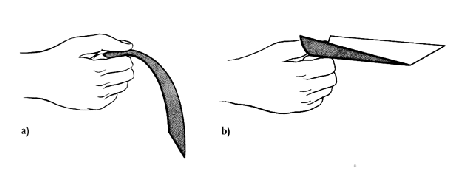
Fig. 3 The influence of curvature in membranes: a) without curvature, and b) with curvature. Source: John A. Ochsendorf from (Anderson 2004: pp. 95)
2.2. Form in Nature
Benyus states that ‘organisms have evolved to work smarter, not harder (Benyus 1997: pp. 5), with their forms synonymous with their function and often further economised by combining one structure to serve multiple functions (Benyus 1997: pp. 265). The reason for nature using materials and energy sparingly, as Benyus explains is a matter of survival (Benyus 1997: pp. 5) whereby through the power of limits, nature ‘optimises rather than maximises’ (Benyus 1997: pp. 4). She highlights that species ‘build for durability, but they don’t overbuild’ and nature also benefits through the use of composite materials to gain strength rather than bulk (Benyus 1997: pp. 265).
Thompson (1917: pp. 11) hypethised that ‘the form of an object is a ‘diagram of forces.’ He further explains that the form of an organism is both the result of internal and external forces by which it is and has been subjected. The form is affected internally by the phenomenon of growth, whereby materials will be redistributed, at varying rates to different parts. Externally the form is influenced and resisted by forces such as surface-tension and gravity (1917: pp. 53). Thompson states; ‘we know, as a fundamental theorem of dynamics that the potential energy of a system tends to a minimum and in that minimum finds, as a matter of course, its stable equilibrium’(1917: pp. 208), or structural stability as the phenomenon is known in the building sector. Thus an objects form will find a balance between internal and external forces. For ‘minute organisms, or the small cellular elements of larger organisms’ Thompson explains their forms ‘will be governed by surface-tension; while the general forms of larger organisms will be due to other non-molecular forces,’ (1917: pp. 215) such as gravity. It is therefore plausible to hypothesise that the forms of orchids are influenced by surface-tensions at the molecular level, although their overall form is more the resulting affect of gravity. As Thompson states ‘gravity not only controls the actions but also influences the forms of all save the least of organisms,’ and thus forms in nature share the same major limitation as the built environment and therefore provide direct relevance as mentors.
Whilst the forms in nature provide a plethora of structural inspiration, the reader must appreciate as Tsui warns that ‘one cannot simply take a chosen form and attempt to enlarge or reduce it without dangerous consequence’ (Tsui 2007: pp. 21). The reason for this as Tsui and Thompson both highlight is a phenomenon known as scales of magnitude, whereby the rate by which volumes increase in comparison to linear dimensions and areas is significantly greater. For example, if a form is at a scale of 1:1, with a linear dimension of one, a surface area of one and a volume of one, the relationship between how these grow when the form is enlarged become exponentially different. If the form was increased by a factor of eight, so that its scale is 8:1, its linear length becomes eight, its area becomes 64 and its volume explodes to 512. The more one enlarged the form, the greater the disparity becomes between its linear dimensions, area and volume. So although by enlarging a form, the cross-section of the form is enlarged accordingly, perhaps suggestive that the relationship is unaltered, in reality the relationship between internal strength and external forces by which it was originally formed has been changed significantly. To maintain this relationship; the stable equilibrium, the material strength would also have to increase by the same factor by which the form is enlarged. Thompson highlights that this phenomenon limits the size in which hollow shells in nature occur as ‘the stresses within which increase much faster than the mere scale of size, every hollow structure, every dome or cylinder, grows weaker as it grows larger’ (1917: pp. 33). Apart from using stronger materials, Tsui suggests we can further overcome the limits of scale by using materials in more economical ways, following even more closely the stresses by which the structure is exposed, adding and subtracting mass where appropriate, as seen in the forms of bones (Tsui 2007: pp. 23). The greatest developments in structural efficiency will come from learning from nature rather than imitating her and by acknowledging this; Antoni Gaudi was well before his time.
2.4. Precedents of Biomimicry in Architecture
What becomes retrospectively apparent as our knowledge of nature continues to expand is that many of mankind’s greatest innovations had already existed in nature in some regard. In fact, those by whom we hold the highest esteem for their contributions to human knowledge were often those who simply had the profound insight to understand the very workings of nature, for this is the basis of science. In architecture, Gaudi’s appreciation for geometry and engineering allowed him to quickly discover deeper profundities in nature, beyond the mere superficialities. He was thus able to express principles, rather than merely imitate nature’s effects.
One geometrical phenomenon found frequently in nature appreciated and used by Gaudi was that of the Helicoid. Charles Darwin in observing the regularity by which certain climbers span around a stem (Fig. 4) hypothesised that “
the stem probably gains rigidity by being twisted (on the same principle that a much twisted rope is stiffer than a slackly twisted one), and is thus indirectly benefited so as to be able to pass over inequalities in its spiral ascent, and able to carry its own weight when allowed to revolve freely.” (Thompson 1917, pp. 625)
Gaudi appreciated that through this torsion, helicoids gain strength and he therefore adopted the form to be used in many of his spiral staircases such as in the towers of the Sagrada Familia Cathedral as seen in Fig.5. Furthermore, the helicoid form is produced using ruled surfaces or from straight-lines generators and thus the form was economical and practical to construct. The use of ruled surfaces was a favoured practice of Gaudi and was also adopted widely by the structural artists who followed. As Timothy Becker highlights its use ‘not only imbues the vaults with grace but also creates forms on demand and with ease, with sound structural properties like those found in nature’ (Anderson 2004: pp. 206).

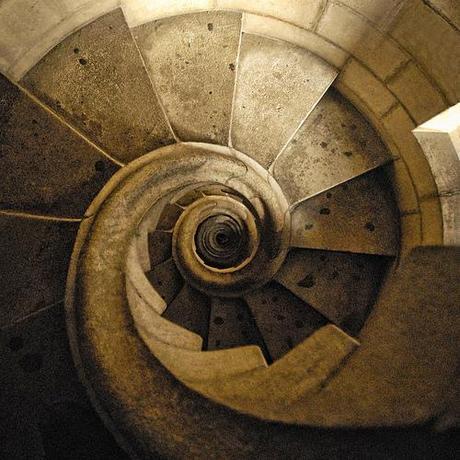
Fig. 4 Helicoidal growth of climber – Source: http://math.arizona.edu/~goriely/res-twining.html
Fig. 5 Gaudi’s use of the Helicoidal form - Source: http://www.flickriver.com/photos/darrellg/4104797739/
Contemporary architect, Santiago Calatrava (1951 – ), like Gaudi, shares a deep fascination for geometry and engineering and turns to nature for inspiration in the development of his forms. Calatrava’s guiding ‘motto “Natura mater et magistra” – nature is both, mother and teacher’ (Tzonis 1999: pp. i), is indicative of Calatrava’s reverence for nature. First created by Gaudi, columns inspired by trees are also often used by Calatrava, the form and arrangement of members elevate the column to play an active role (Descharnes 1971: pp. 15) and thus makes the materials work harder and therefore collectively gains greater structural efficiency. A great deal of Calatrava’s work also takes inspiration from bones and skeletons and a common feature in his work is the adoption of the principle of recurrence. Recurrence is the phenomenon whereby forms such as trees are thicker at the base and taper at the crown where the stresses from dead weight diminish as too the bending moments. Calatrava’s states that ‘to me, there are two overriding principles to be found in nature which are most appropriate for building: one is the optimal use of materials; the other is the capacity of organisms to change shape, to grow, and to move’ (Tzonis 1999: pp. i). Calatrava’s interest in dynamism is reflective of our age, where technology is making it quite plausible for buildings to break the shackles of statics. This appears an inevitably direction for architecture and is likely to be developed with great interest in the coming decades.
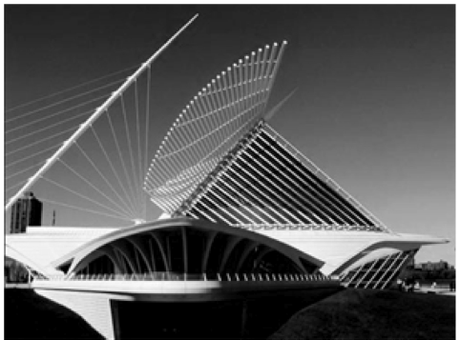
Fig. 6 Dynamic appearance of Quadracci Pavillion
Source: http://theaplusb.blogspot.com/2009_02_01_archive.html
CLICK BELOW to continue reading BIOMIMICRY OF ORCHIDS – PART 3 – Structural Efficiency & Structural Artists
